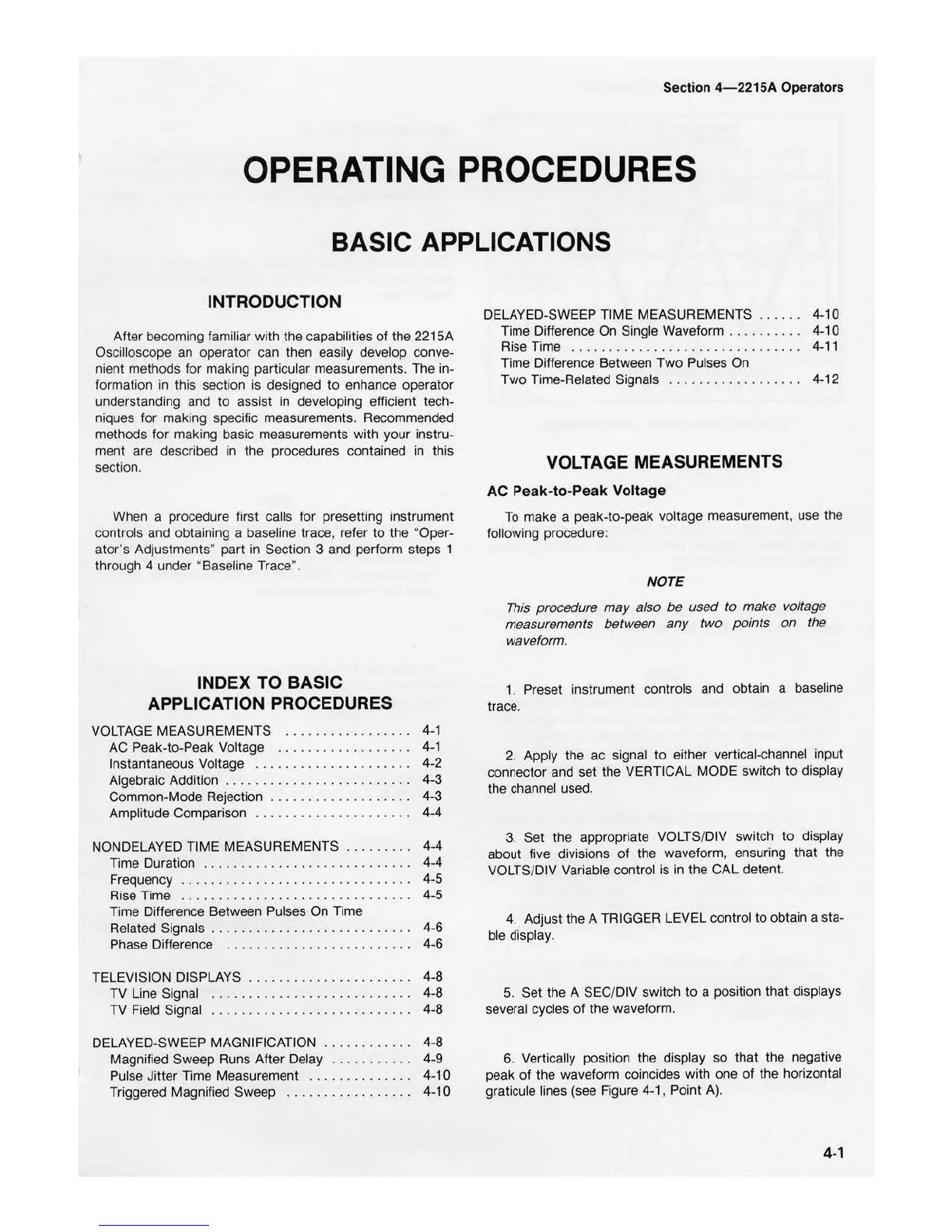Section 4
-22
15A Operators
OPERATING PROCEDURES
BASIC APPLICATIONS
INTRODUCTION
After becoming familiar with the capabilities
of
the
221
SA
Oscilloscope an operator can then easily devel
op
conve-
nient methods for making particular measurements. The in-
formation
in
this section is designed
to
enhance operator
understanding and
to
assist
in
developing efficient tech-
niques for making specific measurements. Recommended
methods for making basic measurements with your instru-
ment are described in the procedures contained in this
section.
When a procedure first calls for presetting instrument
controls and obtaining a baseline trace, refer
to
the "Oper-
ator's Adjustments" part in Section 3 and perform steps 1
through 4 under "Baseline Trace".
INDEX
TO
BASIC
APPLICATION PROCEDURES
VOLTAGE
MEASUREMENTS
...
.
.............
4-1
AC Peak-to-Peak
Vo
ltage . . . . . . . . . . . . . . . . . .
4-1
Instantaneous Voltage . . . . . . . . . . . . . . . . . . . . . 4-2
Algebraic Addition . . . . . . . . . . . . . . . . . . . . . . . . . 4-3
Common-Mode Rejection . . . . . . . . . . . . . . . . . . . 4-3
Amplitude Comparison . . . . . . . . . . . . . . . . . . . . . 4-4
NONDELAYED TIME MEASUREMENTS . . . . . . . . . 4-4
Time Duration . . . . . . . . . . . . . . . . . . . . . . . . . . . . 4-4
Frequency . . . . . . . . . . . . . . . . . . . . . . . . . . . . . . . 4-5
Rise Time . . . . . . . . . . . . . . . . . . . . . . . . . . . . . . . 4-5
Time Difference Between Pulses On Time
Related Signals . . . . . . . . . . . . . . . . . . . . . . . . . . . 4-6
Phase Difference . . . . . . . . . . . . . . . . . . . . . . . . . 4-6
TELEVISION DISPLAYS . . . . . . . . . . . . . . . . . . . . . . 4-8
TV Line Signal . . . . . . . . . . . . . . . . . . . . . . . . . . . 4-8
TV Field Signal . . . . . . . . . . . . . . . . . . . . . . . . . . . 4-8
DELAYED-SWEEP MAGNIFICATION . . . . . . . . . . . . 4-8
Magnified Sweep Runs After
De
lay . . . . . . . . . . . 4-9
Pulse Jitter Time Measurement . . . . . . . . . . . . . . 4
-1
0
Triggered Magnified Sweep . . . . . . . . . . . . . . . . .
4-1
O
DELAYED-SWEEP TIME MEASUREMENTS . . . . . . 4-10
Time Difference On Single Waveform . . . . . . . . . . 4-10
Rise Time . . . . . . . . . . . . . . . . . . . . . . . . . . . . . . .
4-11
Time Difference Between
Two
Pulses On
Two Time-Related Signals . . . . . . . . . . . . . . . . . . 4-12
VOLTAGE MEASUREMENTS
AC Peak-to-Peak Voltage
To
make a peak-to-peak voltage measurement, use the
following procedure:
N
OTE
This
procedure may also be used to make voltage
measurements between any two points on the
waveform.
1 . Preset instrument controls and obtain a baseline
t
race.
2. Apply the ac signal
to
either vertical-channel input
connector and set the VERTICAL MODE switch
to
display
the channel used.
3.
Set the appropriate VOLTS/DIV
sw
itch
to
display
about five divisions
of
the waveform, ensu
ri
ng that the
VOLTS/DIV Variable control is in the CAL detent.
4. Adjust the A TRI
GGER
LEVEL control
to
obtain a sta-
ble display.
5. Set the A SEC/DIV switch
to
a position th
at
displays
several cycles
of
the waveform.
6. Vertically position the display so that the negative
peak
of
the waveform coincides with one
of
the horizontal
graticule lines (see Figure 4-1, Point
A).
4-1

